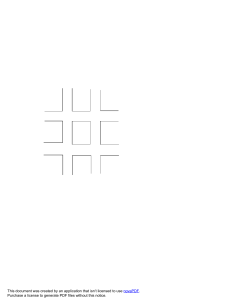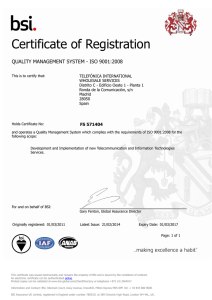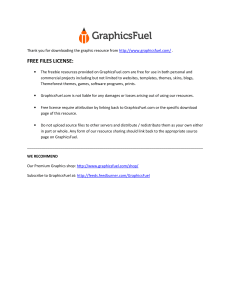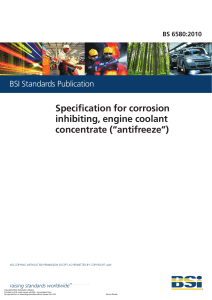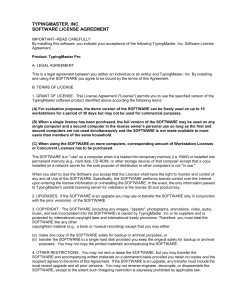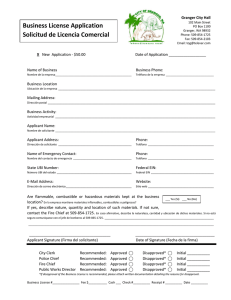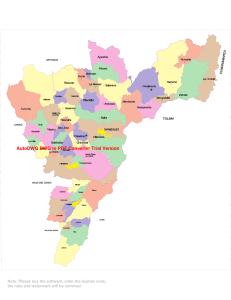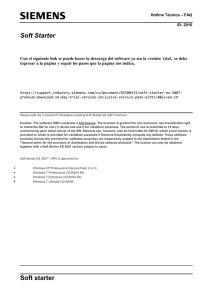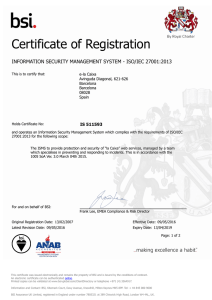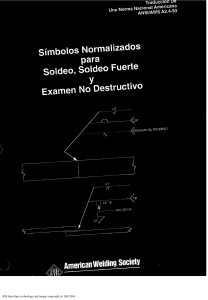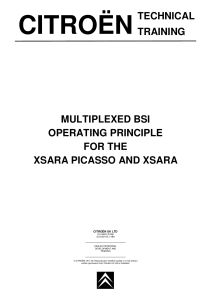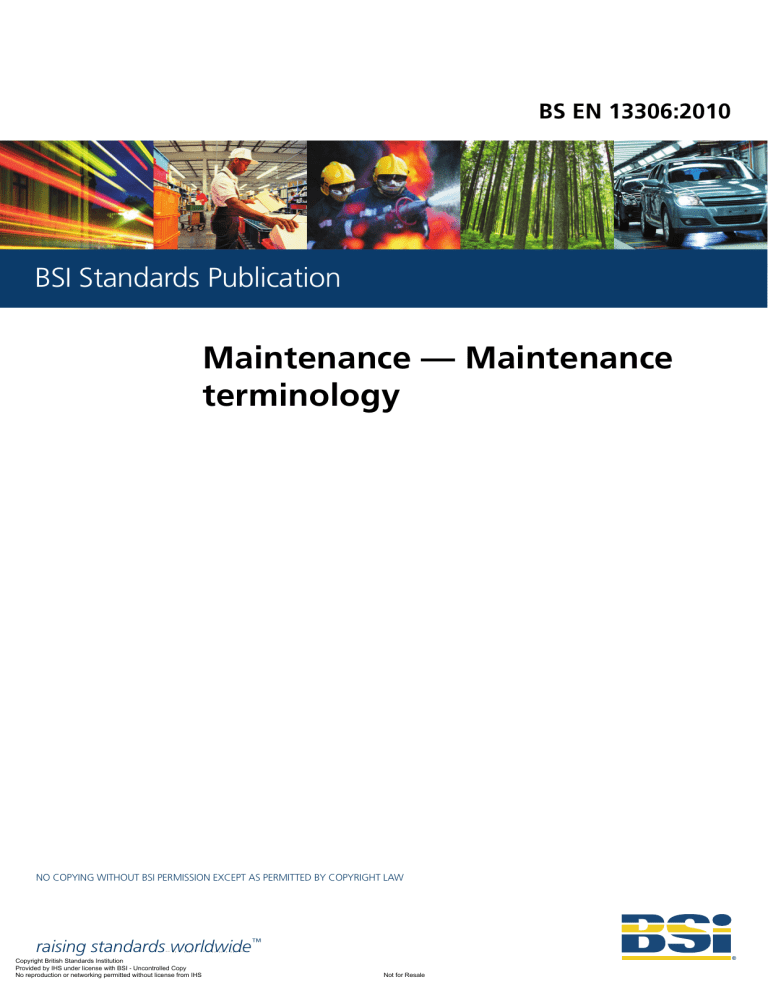
BS EN 13306:2010 BSI Standards Publication Maintenance — Maintenance terminology NO COPYING WITHOUT BSI PERMISSION EXCEPT AS PERMITTED BY COPYRIGHT LAW raising standards worldwide™ --`,,```,,,,````-`-`,,`,,`,`,,`--- Copyright British Standards Institution Provided by IHS under license with BSI - Uncontrolled Copy No reproduction or networking permitted without license from IHS Not for Resale BS EN 13306:2010 BRITISH STANDARD National foreword This British Standard is the UK implementation of EN 13306:2010. It supersedes BS EN 13306:2001 which is withdrawn. The UK participation in its preparation was entrusted to Technical Committee DS/1, Dependability and terotechnology. A list of organizations represented on this committee can be obtained on request to its secretary. This publication does not purport to include all the necessary provisions of a contract. Users are responsible for its correct application. © BSI 2010 ISBN 978 0 580 64184 8 ICS 01.040.03; 03.080.10 Compliance with a British Standard cannot confer immunity from legal obligations. This British Standard was published under the authority of the Standards Policy and Strategy Committee on 30 November 2010. Amendments issued since publication Date Text affected --`,,```,,,,````-`-`,,`,,`,`,,`--- Copyright British Standards Institution Provided by IHS under license with BSI - Uncontrolled Copy No reproduction or networking permitted without license from IHS Not for Resale BS EN 13306:2010 EN 13306 EUROPEAN STANDARD NORME EUROPÉENNE EUROPÄISCHE NORM August 2010 ICS 01.040.03; 03.080.10 Supersedes EN 13306:2001 English Version Maintenance - Maintenance terminology Maintenance - Terminologie de la maintenance Instandhaltung - Begriffe der Instandhaltung This European Standard was approved by CEN on 9 July 2010. CEN members are bound to comply with the CEN/CENELEC Internal Regulations which stipulate the conditions for giving this European Standard the status of a national standard without any alteration. Up-to-date lists and bibliographical references concerning such national standards may be obtained on application to the CEN Management Centre or to any CEN member. This European Standard exists in three official versions (English, French, German). A version in any other language made by translation under the responsibility of a CEN member into its own language and notified to the CEN Management Centre has the same status as the official versions. CEN members are the national standards bodies of Austria, Belgium, Bulgaria, Croatia, Cyprus, Czech Republic, Denmark, Estonia, Finland, France, Germany, Greece, Hungary, Iceland, Ireland, Italy, Latvia, Lithuania, Luxembourg, Malta, Netherlands, Norway, Poland, Portugal, Romania, Slovakia, Slovenia, Spain, Sweden, Switzerland and United Kingdom. --`,,```,,,,````-`-`,,`,,`,`,,`--- EUROPEAN COMMITTEE FOR STANDARDIZATION COMITÉ EUROPÉEN DE NORMALISATION EUROPÄISCHES KOMITEE FÜR NORMUNG Management Centre: Avenue Marnix 17, B-1000 Brussels © 2010 CEN All rights of exploitation in any form and by any means reserved worldwide for CEN national Members. Copyright British Standards Institution Provided by IHS under license with BSI - Uncontrolled Copy No reproduction or networking permitted without license from IHS Not for Resale Ref. No. EN 13306:2010: E BS EN 13306:2010 EN 13306:2010 (E) Contents Page Foreword ..............................................................................................................................................................3 Introduction .........................................................................................................................................................4 1 Scope ......................................................................................................................................................5 2 Fundamental terms ................................................................................................................................5 3 Item related terms ..................................................................................................................................6 4 Properties of items ................................................................................................................................7 5 Failures and events ...............................................................................................................................9 6 Faults and states................................................................................................................................. 11 7 Maintenance types .............................................................................................................................. 12 8 Maintenance activities ........................................................................................................................ 14 9 Time related terms .............................................................................................................................. 16 10 Maintenance support and tools......................................................................................................... 18 11 Economic and technical factors........................................................................................................ 18 Annex A (informative) Maintenance – Overall view ...................................................................................... 20 Annex B (informative) States of an item ........................................................................................................ 21 Annex C (informative) Times ........................................................................................................................... 22 Annex D (informative) Maintenance times ..................................................................................................... 23 Annex E (informative) Criticality matrix ......................................................................................................... 24 Annex F (informative) Identification of significant technical changes between this standard and the previous edition (EN 13306:2001) ............................................................................................... 25 Bibliography ..................................................................................................................................................... 26 Index .............................................................................................................................................................. 27 2 Copyright British Standards Institution Provided by IHS under license with BSI - Uncontrolled Copy No reproduction or networking permitted without license from IHS --`,,```,,,,````-`-`,,`,,`,`,,`--- Not for Resale BS EN 13306:2010 EN 13306:2010 (E) Foreword This document (EN 13306:2010) has been prepared by Technical Committee CEN/TC 319 “Maintenance”, the secretariat of which is held by UNI. This European Standard shall be given the status of a national standard, either by publication of an identical text or by endorsement, at the latest by February 2011, and conflicting national standards shall be withdrawn at the latest by February 2011. Attention is drawn to the possibility that some of the elements of this document may be the subject of patent rights. CEN [and/or CENELEC] shall not be held responsible for identifying any or all such patent rights. This document supersedes EN 13306:2001. According to the CEN/CENELEC Internal Regulations, the national standards organizations of the following countries are bound to implement this European Standard: Austria, Belgium, Bulgaria, Croatia, Cyprus, Czech Republic, Denmark, Estonia, Finland, France, Germany, Greece, Hungary, Iceland, Ireland, Italy, Latvia, Lithuania, Luxembourg, Malta, Netherlands, Norway, Poland, Portugal, Romania, Slovakia, Slovenia, Spain, Sweden, Switzerland and the United Kingdom. --`,,```,,,,````-`-`,,`,,`,`,,`--- Copyright British Standards Institution Provided by IHS under license with BSI - Uncontrolled Copy No reproduction or networking permitted without license from IHS Not for Resale 3 BS EN 13306:2010 EN 13306:2010 (E) Introduction The purpose of this European Standard is to define the generic terms used for all types of maintenance and maintenance management irrespective of the type of item considered. Maintenance of software only is not covered in this standard. However, maintenance of items and systems containing software is considered. It is the responsibility of any maintenance management to define its maintenance strategy according to the following main objectives: to ensure the availability of the item to function as required, at optimum costs; to consider the safety and any other mandatory requirements associated with the item; to consider any impact on the environment; to uphold the durability of the item and/or the quality of the product or service provided considering costs where necessary. As a part of the requirement of CEN/TC 319 it was necessary to produce a comprehensive structured generic maintenance vocabulary standard containing the main terms and their definitions. Maintenance provides an essential contribution to the dependability of an item. Correct and formal definitions are required which will give the user of associated maintenance standards a fuller understanding of the maintenance terms used. These terms may be of particular importance in the formulation of maintenance contracts. The terms contained in this standard indicate that maintenance is not confined to the technical actions alone but includes other activities such as planning, documentation handling, etc. The standard IEC 60050-191 has been used as a basis for the preparation of this standard but some terms have been modified. Not all terms specified in IEC 60050-191 are included in this European Standard. Readers are referred to this IEC standard for further definitions. --`,,```,,,,````-`-`,,`,,`,`,,`--- 4 Copyright British Standards Institution Provided by IHS under license with BSI - Uncontrolled Copy No reproduction or networking permitted without license from IHS Not for Resale BS EN 13306:2010 EN 13306:2010 (E) 1 Scope This European Standard specifies generic terms and definitions for the technical, administrative and managerial areas of maintenance. It may not be applicable to terms which are used for the maintenance of software only. 2 Fundamental terms 2.1 maintenance combination of all technical, administrative and managerial actions during the life cycle of an item intended to retain it in, or restore it to, a state in which it can perform the required function NOTE See also the definitions of improvement and modification. --`,,```,,,,````-`-`,,`,,`,`,,`--- 2.2 maintenance management all activities of the management that determine the maintenance objectives, strategies and responsibilities, and implementation of them by such means as maintenance planning, maintenance control, and the improvement of maintenance activities and economics 2.3 maintenance objective target assigned and accepted for the maintenance activities NOTE These targets may include for example availability, cost reduction, product quality, environment preservation, safety, asset value preservation. 2.4 maintenance strategy management method used in order to achieve the maintenance objectives NOTE Examples could be outsourcing of maintenance, allocation of resources, etc. 2.5 maintenance plan structured and documented set of tasks that include the activities, procedures, resources and the time scale required to carry out maintenance 2.6 required function function, combination of functions, or a total combination of functions of an item which are considered necessary to provide a given service NOTE 1 To provide a given service may also include asset value preservation. NOTE 2 The given service may be expressed or implied and may in some cases be below the original design specifications. 2.7 dependability ability to perform as and when required NOTE 1 Dependability characteristics include availability and its influencing factors (reliability, recoverability, maintainability, maintenance support performance) and, in some cases, durability, economics, integrity, safety, security and conditions of use. Copyright British Standards Institution Provided by IHS under license with BSI - Uncontrolled Copy No reproduction or networking permitted without license from IHS 5 Not for Resale BS EN 13306:2010 EN 13306:2010 (E) NOTE 2 Dependability is used descriptively as an umbrella term for the time-related quality characteristics of a product or service. 2.8 maintenance supportability maintenance support performance ability of a maintenance organization to have the correct maintenance support at the necessary place to perform the required maintenance activity when required 2.9 operation combination of all technical, administrative and managerial actions, other than maintenance actions, that results in the item being in use NOTE 3 Maintenance actions carried out by operators are not included in operation. Item related terms 3.1 item part, component, device, subsystem, functional unit, equipment or system that can be individually described and considered NOTE 1 A number of items e.g. a population of items, or a sample, may itself be considered as an item. --`,,```,,,,````-`-`,,`,,`,`,,`--- NOTE 2 An item may consist of hardware, software or both. NOTE 3 system. Software consists of programs, procedures, rules, documentation and data of an information processing 3.2 asset (physical) item formally accountable 3.3 repairable item item which may be restored under given conditions, and after a failure to a state in which it can perform a required function NOTE The given conditions may be economical, ecological, technical and/or others. 3.4 consumable item item or material which is expendable, may be regularly replaced and generally is not item specific NOTE Generally, consumable items are relatively low cost compared to the item itself. 3.5 spare part item intended to replace a corresponding item in order to retain or maintain the original required function of the item NOTE 1 The original item may be subsequently repaired. NOTE 2 In English, any item that is dedicated and/or exchangeable for a specific item is often referred to as replacement item. 6 Copyright British Standards Institution Provided by IHS under license with BSI - Uncontrolled Copy No reproduction or networking permitted without license from IHS Not for Resale BS EN 13306:2010 EN 13306:2010 (E) 3.6 insurance spare part spare part which is not normally needed during the useful life of the item but whose unavailability would involve an unacceptable downtime due to its provisioning NOTE asset. If the spare part is expensive then for accountancy purposes such a part may be considered as a capital 3.7 indenture level level of sub-division within an item hierarchy NOTE 1 Examples of indenture levels are: system, subsystem and component. NOTE 2 From the maintenance perspective, the indenture level depends on the complexity of the item's construction, the accessibility to sub-items, skill level of maintenance personnel, test equipment facilities, safety considerations, etc. 4 Properties of items 4.1 availability ability to be in a state to perform as and when required, under given conditions, assuming that the necessary external resources are provided NOTE 1 This ability depends on the combined aspects of the reliability, maintainability and recoverability of the item and the maintenance supportability. NOTE 2 Required external resources, other than maintenance resources, do not affect the availability of the item although the item may not be available from the user’s viewpoint. NOTE 3 Availability may be quantified using appropriate measures or indicators and is then referred to as availability performance. 4.2 reliability ability of an item to perform a required function under given conditions for a given time interval NOTE 1 It is assumed that the item is in a state to performed as required at the beginning of the time interval. NOTE 2 Reliability may be quantified as a probability or performance indicators by using appropriate measures and is then referred to as reliability performance. NOTE 3 In some cases a given number of unit of use can be considered instead of a given time interval (number of cycles, number of running hours, number of kilometres, etc.). 4.3 intrinsic reliability inherent reliability reliability of an item determined by design and manufacture 4.4 maintainability ability of an item under given conditions of use, to be retained in, or restored to, a state in which it can perform a required function, when maintenance is performed under given conditions and using stated procedures and resources NOTE Maintainability may be quantified using appropriate measures or indicators and is then referred to as maintainability performance. --`,,```,,,,````-`-`,,`,,`,`,,`--- Copyright British Standards Institution Provided by IHS under license with BSI - Uncontrolled Copy No reproduction or networking permitted without license from IHS 7 Not for Resale BS EN 13306:2010 EN 13306:2010 (E) 4.5 intrinsic maintainability inherent maintainability maintainability of an item determined by the original design 4.6 conformity fulfilment of a requirement 4.7 durability ability of an item to perform a required function under given conditions of use and maintenance, until a limiting state is reached NOTE 1 A limiting state of an item may be characterized by the end of the useful life. NOTE 2 The limiting state may be redefined by changes in conditions of use. 4.8 redundancy in an item, existence of more than one means for performing a required function when needed 4.9 active redundancy redundancy wherein more than one means for performing a required function are operating simultaneously 4.10 standby redundancy redundancy wherein an alternative means for performing the particular function is only activated when the active means is unavailable NOTE Standby redundancy is often referred to as passive redundancy 4.11 useful life time interval from a given instant until the instant when a limiting state is reached NOTE The limiting state may be a function of failure rate, maintenance support requirement, physical condition, economics, age, obsolescence, changes in the user's requirements or other relevant factors. 4.12 mean failure rate number of failures of an item in a given time interval divided by the time interval NOTE In some cases unit of time can be replaced by units of use. 4.13 life cycle series of stages through which an item goes, from its conception to disposal 4.14 obsolescence (for maintenance purposes) inability of an item to be maintained due to the unavailability on the market of the necessary resources at acceptable technical and/or economic conditions NOTE 1 The necessary resources can be: one (or more) sub-item needed to restore the item; --`,,```,,,,````-`-`,,`,,`,`,,`--- 8 Copyright British Standards Institution Provided by IHS under license with BSI - Uncontrolled Copy No reproduction or networking permitted without license from IHS Not for Resale BS EN 13306:2010 EN 13306:2010 (E) tools or monitoring or testing devices; documentary resources; skills; etc. 5 The unavailability of the resources can be due to: technological development; market situation; absence of supplier; regulations. --`,,```,,,,````-`-`,,`,,`,`,,`--- NOTE 2 Failures and events 5.1 failure termination of the ability of an item to perform a required function NOTE 1 After failure the item has a fault, which may be complete or partial. NOTE 2 "Failure" is an event, as distinguished from "fault", which is a state. NOTE 3 The concept as defined does not apply to items consisting of software only. 5.2 failure mode manner in which the inability of an item to perform a required function occurs NOTE 1 The use of the term "fault mode" is deprecated. NOTE 2 A failure mode may be defined by the function lost or the state transition that occurred. 5.3 failure cause circumstances during specification, design, manufacture, installation, use or maintenance that result in failure 5.4 wear-out-failure failure whose probability of occurrence increases with the operating time or the number of operations of the item and the associated applied stresses NOTE Wear-out is a physical phenomenon which results in a loss, deformation or change of material. 5.5 ageing failure failure whose probability of occurrence increases with the passage of calendar time NOTE 1 This time is independent of the operating time of the item. NOTE 2 Ageing is a physical phenomenon which involves a modification of the physical and/or chemical characteristics of the material. Copyright British Standards Institution Provided by IHS under license with BSI - Uncontrolled Copy No reproduction or networking permitted without license from IHS 9 Not for Resale BS EN 13306:2010 EN 13306:2010 (E) 5.6 degradation detrimental change in physical condition, with time, use or external cause NOTE 1 Degradation may lead to a failure. NOTE 2 In a system context, degradation may also be caused by failures within the system. (See "degraded state".) 5.7 common cause failures failures of several items resulting from the same direct cause and where these failures are not consequences of each other NOTE Common cause failures may reduce the effect of system redundancy. 5.8 primary failure failure of an item not caused either directly or indirectly by a failure or a fault of another item 5.9 secondary failure failure of an item caused either directly or indirectly by a failure or a fault of another item 5.10 sudden failure failure that could not be anticipated by prior examination or monitoring 5.11 hidden failure failure which is not detected during normal operation 5.12 failure mechanism physical, chemical or other processes which may lead or have led to failure 5.13 severity (of a failure or a fault) potential or actual detrimental consequences of a failure or a fault NOTE The severity of a failure may be related to safety, availability, costs, quality, environment, etc. 5.14 criticality (of a failure or a fault) numerical index of the severity of a failure or a fault combined with the probability or frequency of its occurrence NOTE The numerical index in this context may be defined, for example, as an area in the frequency of failure occurrence - severity matrix diagram (see Annex E). 5.15 failure criteria pre-defined conditions to be accepted as conclusive evidence of failure EXAMPLE A defined limiting state of wear, crack propagation, performance degradation, leakage, emission, etc. beyond which it is deemed to be unsafe or uneconomic to continue operation. --`,,```,,,,````-`-`,,`,,`,`,,`--- 10 Copyright British Standards Institution Provided by IHS under license with BSI - Uncontrolled Copy No reproduction or networking permitted without license from IHS Not for Resale BS EN 13306:2010 EN 13306:2010 (E) 6 Faults and states 6.1 fault state of an item characterized by inability to perform a required function, excluding the inability during preventive maintenance or other planned actions, or due to lack of external resources NOTE A fault usually results from a failure, but in some circumstances it may be a pre-existing fault. 6.2 fault masking condition in which a fault exists in a sub-item of an item but cannot be recognized because of a fault of the item or because of another fault of that sub-item or of another sub-item NOTE Fault masking may conceal a progressive loss of redundancy. 6.3 latent fault existing fault that has not become apparent 6.4 partial fault fault characterized by the fact that an item can only perform some but not all of the required functions NOTE In some cases it may be possible to use the item with reduced performance. 6.5 up state state of an item characterized by the fact that it can perform a required function, assuming that the external resources, if required, are provided 6.6 degraded state state in which the ability to provide the required function is reduced, but within defined limits of acceptability NOTE A degraded state may be the result of faults at lower indenture levels. 6.7 down state state of an item characterized either by a fault, or by a possible inability to perform a required function during preventive maintenance NOTE 1 This state is related to availability performance. NOTE 2 A down state is sometimes referred to as an internal disabled state. 6.8 disabled state outage state of an item characterised by its inability to perform a required function, for any reason NOTE A disabled state may be either an up or down state. 6.9 external disabled state subset of the disabled state when the item is in an up state, but lacks required external resources or is disabled due to planned actions other than maintenance 11 --`,,```,,,,````-`-`,,`,,`,`,,`--- Copyright British Standards Institution Provided by IHS under license with BSI - Uncontrolled Copy No reproduction or networking permitted without license from IHS Not for Resale BS EN 13306:2010 EN 13306:2010 (E) 6.10 operating state state when an item is performing as required 6.11 idle state state of an item which is in an up state and non-operating, during non-required time 6.12 standby state state of an item which is in an up state and non operating during the required time 6.13 hazardous state state of an item assessed as likely to result in an injury to persons, significant material damage or other unacceptable consequences 6.14 shutdown outage scheduled in advance, for maintenance or other purposes NOTE Shutdown may also be called "planned outage". 6.15 software fault bug condition of a software item that may prevent it from performing as required 7 Maintenance types 7.1 preventive maintenance maintenance carried out at predetermined intervals or according to prescribed criteria and intended to reduce the probability of failure or the degradation of the functioning of an item 7.2 predetermined maintenance preventive maintenance carried out in accordance with established intervals of time or number of units of use but without previous condition investigation NOTE the item. Intervals of times or number of unit of use may be established from knowledge of the failure mechanisms of 7.3 condition based maintenance preventive maintenance which include a combination of condition monitoring and/or inspection and/or testing, analysis and the ensuing maintenance actions NOTE The condition monitoring and/or inspection and/or testing may be scheduled, on request or continuous. 7.4 predictive maintenance condition based maintenance carried out following a forecast derived from repeated analysis or known characteristics and evaluation of the significant parameters of the degradation of the item --`,,```,,,,````-`-`,,`,,`,`,,`--- 12 Copyright British Standards Institution Provided by IHS under license with BSI - Uncontrolled Copy No reproduction or networking permitted without license from IHS Not for Resale BS EN 13306:2010 EN 13306:2010 (E) 7.5 corrective maintenance maintenance carried out after fault recognition and intended to put an item into a state in which it can perform a required function 7.6 deferred corrective maintenance corrective maintenance which is not immediately carried out after a fault detection but is delayed in accordance with given rules 7.7 immediate corrective maintenance corrective maintenance that is carried out without delay after a fault has been detected to avoid unacceptable consequences 7.8 scheduled maintenance maintenance carried out in accordance with an established time schedule or established number of units of use NOTE Corrective deferred maintenance may also be scheduled. 7.9 remote maintenance maintenance of an item carried out without physical access by the personnel to the item 7.10 on line maintenance maintenance carried out on the item whilst it is operating and without impact on its performance NOTE In this type of maintenance it is important that all the safety procedures are followed. 7.11 on site maintenance maintenance carried out at the location where the item is normally located 7.12 operator maintenance maintenance actions carried out by an operator Such maintenance actions should be clearly defined. 7.13 maintenance level level of maintenance maintenance task categorisation by complexity NOTE 1 These tasks are divided into levels of increasing complexity. EXAMPLES --`,,```,,,,````-`-`,,`,,`,`,,`--- NOTE Level 1 is characterized by simple actions carried out with minimal training. Level 2 is characterized by basic actions which should be carried out by qualified personnel using detailed procedures. Level 3 is characterized by complex actions carried out by qualified technical personnel using detailed procedures. Level 4 is characterized by actions which imply the know-how of a technique or a technology and carried out by specialized technical personnel. Copyright British Standards Institution Provided by IHS under license with BSI - Uncontrolled Copy No reproduction or networking permitted without license from IHS 13 Not for Resale BS EN 13306:2010 EN 13306:2010 (E) Level 5 is characterized by actions which imply a knowledge held by the manufacturer or a specialized company with industrial logistic support equipment. NOTE 2 The maintenance level may be related to the indenture level. 7.14 maintenance outsourcing contracting out of all or part of the maintenance activities of an organisation for a stated period of time NOTE In the case of complete outsourcing of all maintenance activities this is referred to as "complete maintenance outsourcing". 8 Maintenance activities 8.1 inspection examination for conformity by measuring, observing, or testing the relevant characteristics of an item 8.2 condition monitoring activity, performed either manually or automatically, intended to measure at predetermined intervals the characteristics and parameters of the actual state of an item NOTE 1 Monitoring is distinguished from inspection in that it is used to evaluate any changes in the parameters of the item with time. Monitoring may be continuous, over time interval or after a given number of operations. NOTE 3 Monitoring is usually carried out in the operating state. --`,,```,,,,````-`-`,,`,,`,`,,`--- NOTE 2 8.3 compliance test test used to show whether or not a characteristic or a property of an item complies with the stated requirements 8.4 function check-out action taken after maintenance actions to verify that the item is able to perform as required NOTE Function check is usually carried out after down state. 8.5 routine maintenance regular or repeated simple preventive maintenance activities NOTE Routine maintenance may include for example cleaning, tightening of connections, replacement of connectors, checking liquid level, lubrication, etc. 8.6 overhaul comprehensive set of preventive maintenance actions carried out, in order to maintain the required level of performance of an item NOTE 1 Overhaul may be performed at prescribed intervals of time or number of operations. NOTE 2 Overhaul may require a complete or partial dismantling of the item. 14 Copyright British Standards Institution Provided by IHS under license with BSI - Uncontrolled Copy No reproduction or networking permitted without license from IHS Not for Resale BS EN 13306:2010 EN 13306:2010 (E) 8.7 fault diagnosis actions taken for fault recognition, fault localization and identification of causes 8.8 fault localisation actions taken to identify the faulty item at the appropriate indenture level NOTE These actions may include black-box testing (a means of testing in which tests cases are chosen using only the functional specifications of the item). --`,,```,,,,````-`-`,,`,,`,`,,`--- 8.9 restoration event at which the ability to perform as required is re-established, after a failure 8.10 repair physical action taken to restore the required function of a faulty item NOTE Repair also include fault localisation and function checkout. 8.11 temporary repair physical action taken to allow a faulty item to perform its required function for a limited time interval and until a repair is carried out 8.12 improvement combination of all technical, administrative and managerial actions, intended to ameliorate the reliability and/or the maintainability and/or the safety of an item, without changing the original function NOTE An improvement may also be introduced to prevent misuse in operation and to avoid failures. 8.13 modification combination of all technical, administrative and managerial actions intended to change one or more functions of an item NOTE 1 Modification is not a maintenance action, but has to do with changing the required function of an item to a new required function. The changes may have an influence on the dependability characteristics. NOTE 2 Modification may involve the maintenance organisation. NOTE 3 The change of an item where a different version is replacing the original item without changing the function or ameliorating the dependability of the item is called a replacement and is not a modification. 8.14 rebuilding action following the dismantling of an item and the repair or replacement of those sub-items, that are approaching the end of their useful life and/or should be regularly replaced NOTE 1 Rebuilding differs from overhaul in that the actions may include modifications and/or improvements. NOTE 2 The objective of rebuilding is normally to provide an item with an extended useful life 8.15 maintenance task preparation supplying of all of the necessary information and identifying the required resources to enable the maintenance task to be carried out Copyright British Standards Institution Provided by IHS under license with BSI - Uncontrolled Copy No reproduction or networking permitted without license from IHS 15 Not for Resale BS EN 13306:2010 EN 13306:2010 (E) NOTE The preparation may include description of how to perform the work, reference to valid instructions and/or documentation, required permits, spare part, skill, tools, etc. 8.16 maintenance schedule plan produced in advance detailing when a specific maintenance task should be carried out 9 Time related terms 9.1 up time time interval throughout which an item is in an up state 9.2 down time time interval throughout which an item is in a down state 9.3 operating time time interval throughout which an item is in operating state --`,,```,,,,````-`-`,,`,,`,`,,`--- 9.4 required time time interval throughout which the item is required to be in an up state 9.5 standby time time interval throughout which an item is in a standby state 9.6 idle time time interval throughout which an item is in an idle state 9.7 maintenance time time interval when maintenance is carried out on an item including technical and logistic delays NOTE Maintenance may be carried out while the item is functioning. 9.8 preventive maintenance time part of maintenance time when preventive maintenance is carried out on an item, including logistic delays 9.9 corrective maintenance time part of the maintenance time when active corrective maintenance is carried out on an item, including logistic delays 9.10 active maintenance time part of the maintenance time when active maintenance is carried out on an item, excluding logistic delays NOTE An active maintenance action may be carried out while the item is functioning. 9.11 repair time part of active corrective maintenance time when repair is carried out on an item 16 Copyright British Standards Institution Provided by IHS under license with BSI - Uncontrolled Copy No reproduction or networking permitted without license from IHS Not for Resale BS EN 13306:2010 EN 13306:2010 (E) 9.12 active preventive maintenance task time time interval when an active preventive maintenance task is carried out NOTE All technical delays are excluded from active preventive maintenance task time. 9.13 logistic delay accumulated time when maintenance cannot be carried out due to the need to acquire maintenance resources, excluding any administrative delay NOTE Logistic delays can be due to, for example, travelling to installations, pending arrival of spare parts, specialists, test equipment and information and unsuitable environmental conditions. 9.14 technical delay accumulated time necessary to perform auxiliary technical actions associated with, but not part of, the maintenance action EXAMPLE Rendering the equipment safe, and setting up test equipment. --`,,```,,,,````-`-`,,`,,`,`,,`--- 9.15 operating time to failure accumulated operating times of an item, from the instant it is first into use, until failure or, from the instant of restoration until next failure NOTE 1 Operating time between failures is a special case of operating time to failure. NOTE 2 Time to failure is often used instead of operating time to failure. 9.16 time between failures time duration between two consecutive failures of an item NOTE Time between failures may include non operating time after restoration. 9.17 operating time between failures total time duration of operating time between two consecutive failures of an item 9.18 external disabled time time interval throughout which an item is in an external disabled state 9.19 time to restoration time interval for which an item is in a down state due to a failure NOTE Down time for other reasons, e.g. for preventive maintenance, is excluded. 9.20 wear-out failure period period in the life of an item when the instantaneous failure intensity for a repairable item, or the instantaneous failure rate for a non-repairable item, increases significantly with time 9.21 constant failure period period in the life when the instantaneous failure intensity for a repairable item, or the instantaneous failure rate for a non-repairable item, is approximately constant Copyright British Standards Institution Provided by IHS under license with BSI - Uncontrolled Copy No reproduction or networking permitted without license from IHS 17 Not for Resale BS EN 13306:2010 EN 13306:2010 (E) 9.22 early failure period time interval in early life when the instantaneous failure intensity for a repairable item, or the instantaneous failure rate for a non-repairable item, is significantly higher than that of the subsequent period 10 Maintenance support and tools 10.1 maintenance support provision of resources, services and management necessary to carry out maintenance NOTE tools, etc. The provision may include, for example, personnel, test equipment, workrooms, spare parts, documentation, 10.2 line of maintenance maintenance echelon position in an organization where specified levels of maintenance are to be carried out on an item NOTE 1 Examples of line of maintenance are: field (first line maintenance), workshop (second line maintenance) and manufacturer (third line maintenance). NOTE 2 The lines of maintenance are characterized by the skill required of the personnel, the facilities available, the location, the complexity of the maintenance task, etc. 10.3 failure analysis logical and systematic examination of item failure modes and causes before or after a failure to identify the consequences of failure as well as the probability of its occurrence NOTE Failure analysis is generally performed to improve dependability 10.4 item register record of individually identified items NOTE 1 Additional information such as location may also be stored on the item register. NOTE 2 The level of individual items to be registered should be specified. 10.5 maintenance record part of maintenance documentation which contains the history of all maintenance related data for an item NOTE data. The history may contain records of all failures, faults, costs, item availability, up time and any other relevant 11 Economic and technical factors 11.1 life cycle cost all of the costs generated during the life cycle of the item NOTE For a user or an owner of an item, the total life cycle cost may include only those costs pertaining to acquisition, operation, maintenance and disposal. --`,,```,,,,````-`-`,,` 18 Copyright British Standards Institution Provided by IHS under license with BSI - Uncontrolled Copy No reproduction or networking permitted without license from IHS Not for Resale BS EN 13306:2010 EN 13306:2010 (E) 11.2 mean operating time between failures MTBF average of the operating times between failures NOTE 1 In the field of reliability, mean operating time between failures is defined as the mathematical expectation of the operating time between failures. NOTE 2 This term is applied to repairable items. 11.3 mean time between failures average of the times between failures NOTE In the field of reliability, mean time between failures is defined as the mathematical expectation of the time between failures. 11.4 mean repair time MRT average of the repair times NOTE In the field of reliability, mean repair time is defined as the mathematical expectation of the repair time. --`,,```,,,,````-`-`,,`,,`,`,,`--- 11.5 mean time to restoration MTTR average of the times to restoration Copyright British Standards Institution Provided by IHS under license with BSI - Uncontrolled Copy No reproduction or networking permitted without license from IHS 19 Not for Resale BS EN 13306:2010 EN 13306:2010 (E) Annex A (informative) Maintenance – Overall view Maintenance Corrective Maintenance Condition Based Maintenance Predetermined Maintenance Scheduled, on request or continuous Scheduled Deferred Figure A.1 20 Copyright British Standards Institution Provided by IHS under license with BSI - Uncontrolled Copy No reproduction or networking permitted without license from IHS Not for Resale Immediate --`,,```,,,,````-`-`,,`,,`,`,,`--- Preventive Maintenance BS EN 13306:2010 EN 13306:2010 (E) Annex B (informative) States of an item UP STATE IDLE STATE STAND BY STATE DOWN STATE EXTERNAL DISABLED STATE OPERATING STATE DISABLED STATE NON REQUIRED TIME REQUIRED TIME NON REQUIRED TIME REQUIRED TIME Figure B.1 --`,,```,,,,````-`-`,,`,,`,`,,`--- Copyright British Standards Institution Provided by IHS under license with BSI - Uncontrolled Copy No reproduction or networking permitted without license from IHS Not for Resale 21 BS EN 13306:2010 EN 13306:2010 (E) Annex C (informative) Times Failure Preventive Maintenance Preventive Maintenance (in operation) Failure Preventive Maintenance Failure Required time Non required time (Up state) Up time (Down state) down time (operating) operating time Outage Corrective Maintenance time Preventive Maintenance time Operating Time Between Failures Idle time Figure C.1 --`,,```,,,,````-`-`,,`,,`,`,,`--- 22 Copyright British Standards Institution Provided by IHS under license with BSI - Uncontrolled Copy No reproduction or networking permitted without license from IHS Not for Resale BS EN 13306:2010 EN 13306:2010 (E) Annex D (informative) Maintenance times --`,,```,,,,````-`-`,,`,,`,`,,`--- MAINTENANCE TIME CORRECTIVE MAINTENANCE TIME PREVENTIVE MAINTENANCE TIME ACTIVE PREVENTIVE MAINTENANCE TIME LOGISTIC DELAY TECHNICAL DELAY ACTIVE PM TASK TIME ACTIVE CORRECTIVE MAINTENANCE TIME TECHNICAL DELAY LOGISTIC DELAY REPAIR TIME ACTIVE MAINTENANCE TIME Figure D.1 Copyright British Standards Institution Provided by IHS under license with BSI - Uncontrolled Copy No reproduction or networking permitted without license from IHS 23 Not for Resale BS EN 13306:2010 EN 13306:2010 (E) Annex E (informative) Criticality matrix Failure frequency frequent High criticality rare Low criticality Severity of failure or fault Not severe Very severe Figure E.1 24 --`,,```,,,,````-`-`,,`,,`,`,,`--- Copyright British Standards Institution Provided by IHS under license with BSI - Uncontrolled Copy No reproduction or networking permitted without license from IHS Not for Resale BS EN 13306:2010 EN 13306:2010 (E) Annex F (informative) Identification of significant technical changes between this standard and the previous edition (EN 13306:2001) New clauses and annexes in the current edition 2.9 Operation 3.6 Insurance spare part 4.3 Intrinsic (inherent) Reliability 4.5 Intrinsic (inherent) Maintainability 4.12 Mean failure rate 4.14 Obsolescence (for maintenance purposes) 5.2 Failure mode 5.11 Hidden failure 5.13 Severity 5.14 Criticality 5.15 Failure criteria 6.15 Software fault 7.13 Maintenance level 7.14 Maintenance outsourcing 8.9 Restoration 8.15 Maintenance task preparation 8.16 Maintenance schedule 9.12 Active preventive maintenance task time 9.14 Technical delay 9.15 Operating time to failure 9.22 Early failure period 11.5 Mean time to restoration Annex D Maintenance Times Annex E Criticality matrix Modified clauses and annexes in the current edition Clause 2 to Clause 11 and Annexes A to C have been reviewed and updated. Deleted clauses of 2001 edition 3.4 Repaired item 4.10 Rate of occurrence of failure 6.5 Fault mode 6.6 Actual state 9.13 Time to failure 10.4 Fault analysis 10.5 Maintenance documentation 11.2 Maintenance effectiveness 11.3 Maintenance support efficiency 25 --`,,```,,,,````-`-`,,`,,`,`,,`--- Copyright British Standards Institution Provided by IHS under license with BSI - Uncontrolled Copy No reproduction or networking permitted without license from IHS Not for Resale BS EN 13306:2010 EN 13306:2010 (E) Bibliography [1] IEC 60050-191, International Electrotechnical Vocabulary. Chapter 191: Dependability and quality of service --`,,```,,,,````-`-`,,`,,`,`,,`--- 26 Copyright British Standards Institution Provided by IHS under license with BSI - Uncontrolled Copy No reproduction or networking permitted without license from IHS Not for Resale BS EN 13306:2010 EN 13306:2010 (E) Index 1) active maintenance time 9.10 active preventive maintenance task time 9.12 active redundancy 4.9 ageing failure 5.5 asset (physical) 3.2 availability 4.1 bug 6.15 common cause failures 5.7 compliance test 8.3 condition based maintenance 7.3 condition monitoring 8.2 conformity 4.6 --`,,```,,,,````-`-`,,`,,`,`,,`--- constant failure period 9.21 consumable item 3.4 corrective maintenance 7.5 corrective maintenance time 9.9 criticality (of a failure or a fault) 5.14 deferred corrective maintenance 7.6 degradation 5.6 degraded state 6.6 dependability 2.7 disabled state 6.8 down state 6.7 down time 9.2 durability 4.7 1) Alphabetical listing of English terms. Copyright British Standards Institution Provided by IHS under license with BSI - Uncontrolled Copy No reproduction or networking permitted without license from IHS 27 Not for Resale BS EN 13306:2010 EN 13306:2010 (E) early failure period 9.22 external disabled state 6.9 external disabled time 9.18 failure 5.1 failure analysis 10.3 failure cause 5.3 failure criteria 5.15 failure mechanism 5.12 failure mode 5.2 fault 6.1 fault diagnosis 8.7 fault localisation 8.8 fault masking 6.2 function check-out 8.4 hazardous state 6.13 hazardous state 6.14 hidden failure 5.11 idle state 6.11 idle time 9.6 immediate corrective maintenance 7.7 improvement 8.12 indenture level 3.7 inherent maintainability 4.5 inherent reliability 4.3 inspection 8.1 insurance spare part 3.6 intrinsic maintainability 4.5 intrinsic reliability 4.3 item 3.1 --`,,```,,,,````-`-`,,`,,`,`,,`--- 28 Copyright British Standards Institution Provided by IHS under license with BSI - Uncontrolled Copy No reproduction or networking permitted without license from IHS Not for Resale BS EN 13306:2010 EN 13306:2010 (E) item register 10.4 latent fault 6.3 level of maintenance 7.13 life cycle 4.13 life cycle cost 11.1 line of maintenance 10.2 logistic delay 9.13 maintainability 4.4 maintenance 2.1 maintenance echelon 10.2 maintenance level 7.13 maintenance management 2.2 --`,,```,,,,````-`-`,,`,,`,`,,`--- maintenance objective 2.3 maintenance outsourcing 7.14 maintenance plan 2.5 maintenance record 10.5 maintenance schedule 8.16 maintenance strategy 2.4 maintenance support 10.1 maintenance supportability 2.8 maintenance support performance 2.8 maintenance task preparation 8.15 maintenance time 9.7 mean failure rate 4.12 mean operating time between failures 11.2 mean repair time 11.4 mean time between failures 11.3 mean time to restoration 11.5 modification 8.13 Copyright British Standards Institution Provided by IHS under license with BSI - Uncontrolled Copy No reproduction or networking permitted without license from IHS 29 Not for Resale BS EN 13306:2010 EN 13306:2010 (E) MRT 11.4 MTBF 11.2 MTTR 11.5 obsolescence (for maintenance purposes) 4.14 on line maintenance 7.10 on site maintenance 7.11 operating state 6.10 operating time 9.3 operating time between failures 9.17 operating time to failure 9.15 operation 2.9 operator maintenance 7.12 outage 6.8 overhaul 8.6 partial fault 6.4 predetermined maintenance 7.2 predictive maintenance 7.4 preventive maintenance 7.1 preventive maintenance time 9.8 primary failure 5.8 rebuilding 8.14 redundancy 4.8 reliability 4.2 remote maintenance 7.9 --`,,```,,,,````-`-`,,`,,`,`,,`--- repair 8.10 repair time 9.11 repairable item 3.3 required function 2.6 required time 9.4 30 Copyright British Standards Institution Provided by IHS under license with BSI - Uncontrolled Copy No reproduction or networking permitted without license from IHS Not for Resale BS EN 13306:2010 EN 13306:2010 (E) restoration 8.9 routine maintenance 8.5 scheduled maintenance 7.8 secondary failure 5.9 severity (of a failure or a fault) 5.13 software fault 6.15 spare part 3.5 standby redundancy 4.10 standby state 6.12 standby time 9.5 sudden failure 5.10 technical delay 9.14 temporary repair 8.11 time between failures 9.16 time to restoration 9.19 up state 6.5 up time 9.1 useful life 4.11 wear-out failure period 9.20 wear-out-failure 5.4 --`,,```,,,,````-`-`,,`,,`,`,,`--- Copyright British Standards Institution Provided by IHS under license with BSI - Uncontrolled Copy No reproduction or networking permitted without license from IHS 31 Not for Resale --`,,```,,,,````-`-`,,`,,`,`,,`--- Copyright British Standards Institution Provided by IHS under license with BSI - Uncontrolled Copy No reproduction or networking permitted without license from IHS This page deliberately left blank Not for Resale --`,,```,,,,````-`-`,,`,,`,`,,`--- Copyright British Standards Institution Provided by IHS under license with BSI - Uncontrolled Copy No reproduction or networking permitted without license from IHS This page deliberately left blank Not for Resale BSI is the independent national body responsible for preparing British Standards and other standards-related publications, information and services. It presents the UK view on standards in Europe and at the international level. It is incorporated by Royal Charter. Revisions Information on standards British Standards are updated by amendment or revision. Users of British Standards should make sure that they possess the latest amendments or editions. It is the constant aim of BSI to improve the quality of our products and services. We would be grateful if anyone finding an inaccuracy or ambiguity while using this British Standard would inform the Secretary of the technical committee responsible, the identity of which can be found on the inside front cover. Tel: +44 (0)20 8996 9001 Fax: +44 (0)20 8996 7001 BSI provides a wide range of information on national, European and international standards through its Knowledge Centre. BSI offers Members an individual updating service called PLUS which ensures that subscribers automatically receive the latest editions of standards. Tel: +44 (0)20 8996 7669 Fax: +44 (0)20 8996 7001 Email: [email protected] Buying standards You may buy PDF and hard copy versions of standards directly using a credit card from the BSI Shop on the website www.bsigroup.com/shop. In addition all orders for BSI, international and foreign standards publications can be addressed to BSI Customer Services. Tel: +44 (0)20 8996 9001 Fax: +44 (0)20 8996 7001 Email: [email protected] In response to orders for international standards, it is BSI policy to supply the BSI implementation of those that have been published as British Standards, unless otherwise requested. Tel: +44 (0)20 8996 7004 Fax: +44 (0)20 8996 7005 Email: [email protected] Various BSI electronic information services are also available which give details on all its products and services. Tel: +44 (0)20 8996 7111 Fax: +44 (0)20 8996 7048 Email: [email protected] BSI Subscribing Members are kept up to date with standards developments and receive substantial discounts on the purchase price of standards. For details of these and other benefits contact Membership Administration. Tel: +44 (0)20 8996 7002 Fax: +44 (0)20 8996 7001 Email: [email protected] Information regarding online access to British Standards via British Standards Online can be found at www.bsigroup.com/BSOL Further information about BSI is available on the BSI website at www.bsigroup.com/standards Copyright Copyright subsists in all BSI publications. BSI also holds the copyright, in the UK, of the publications of the international standardization bodies. Except as permitted under the Copyright, Designs and Patents Act 1988 no extract may be reproduced, stored in a retrieval system or transmitted in any form or by any means – electronic, photocopying, recording or otherwise – without prior written permission from BSI. This does not preclude the free use, in the course of implementing the standard of necessary details such as symbols, and size, type or grade designations. If these details are to be used for any other purpose than implementation then the prior written permission of BSI must be obtained. Details and advice can be obtained from the Copyright & Licensing Manager. Tel: +44 (0)20 8996 7070 Email: [email protected] BSI Group Headquarters 389 Chiswick High Road London W4 4AL UK Tel +44 (0)20 8996 9001 Fax +44 (0)20 8996 7001 www.bsigroup.com/standards raising standards worldwide™ Copyright British Standards Institution Provided by IHS under license with BSI - Uncontrolled Copy No reproduction or networking permitted without license from IHS --`,,```,,,,````-`-`,,`,,`,`,,`--- British Standards Institution (BSI) Not for Resale
